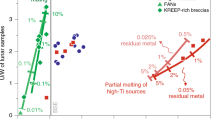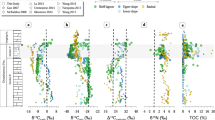Abstract
Solar luminosity on the early Earth was significantly lower than today. Therefore, solar luminosity models suggest that, in the atmosphere of the early Earth, the concentration of greenhouse gases such as carbon dioxide and methane must have been much higher1,2. However, empirical estimates of Proterozoic levels of atmospheric carbon dioxide concentrations have not hitherto been available. Here we present ion microprobe analyses of the carbon isotopes in individual organic-walled microfossils extracted from a Proterozoic (∼ 1.4-gigayear-old) shale in North China. Calculated magnitudes of the carbon isotope fractionation in these large, morphologically complex microfossils suggest elevated levels of carbon dioxide in the ancient atmosphere—between 10 and 200 times the present atmospheric level. Our results indicate that carbon dioxide was an important greenhouse gas during periods of lower solar luminosity, probably dominating over methane after the atmosphere and hydrosphere became pervasively oxygenated between 2 and 2.2 gigayears ago.
This is a preview of subscription content, access via your institution
Access options
Subscribe to this journal
Receive 51 print issues and online access
$199.00 per year
only $3.90 per issue
Buy this article
- Purchase on Springer Link
- Instant access to full article PDF
Prices may be subject to local taxes which are calculated during checkout



Similar content being viewed by others
References
Kasting, J. F. Earth's early atmosphere. Science 259, 920–926 (1993)
Pavlov, A. A., Hurtgen, M. T., Kasting, J. F. & Arthur, M. A. Methane-rich Proterozoic atmosphere? Geology 31, 87–90 (2003)
Xiao, S., Knoll, A. H., Kaufman, A. J., Yin, L. & Zhang, Y. Neoproterozoic fossils in Mesoproterozoic rocks? Chemostratigraphic resolution of a biostratigraphic conundrum from the North China Platform. Precambr. Res. 84, 197–220 (1997)
Brasier, M. D. & Lindsay, J. F. A billion years of environmental stability and the emergence of eukaryotes: New data from northern Australia. Geology 26, 555–558 (1998)
Javaux, E. J., Knoll, A. H. & Walter, M. R. Morphological and ecological complexity in early eukaryotic ecosystems. Nature 412, 66–69 (2001)
Shively, J. M. & Barton, L. L. Variations in Autotrophic Life 1–346 (Academic, New York, 1991)
Schulz, H. et al. Dense populations of a giant sulfur bacterium in Namibian shelf sediments. Science 284, 493–495 (1999)
Cristy, S. S. in Inorganic Mass Spectrometry (eds Barshick, C.M., Duckworth, D.C. & Smith, D.H.) 159–221 (Marcel Dekker, New York, 2000)
House, C. H. et al. Carbon isotope composition of individual Precambrian microfossils. Geology 28, 707–710 (2000)
Ueno, Y., Isozaki, Y., Yurimoto, H. & Maruyama, S. Carbon isotopic signatures of individual Archean microfossils(?) from Western Australia. Int. Geol. Rev. 43, 196–212 (2001)
Hayes, J. M., Strauss, H. & Kaufman, A. J. The abundance of C-13 in marine organic matter and isotopic fractionation in the global biogeochemical cycle of carbon during the past 800 Ma. Chem. Geol. 16, 103–125 (1999)
Laws, E. A., Popp, B. N., Bidigare, R. R., Kennicutt, M. C. & Macko, S. A. Dependence of phytoplankton carbon isotopic composition on growth rate and [CO2(aq)]: Theoretical considerations and experimental results. Geochim. Cosmochim. Acta 59, 1131–1138 (1995)
Laws, E. A., Bidigare, R. R. & Popp, B. N. Effect of growth rate and CO2 concentration on carbon isotopic fractionation by the marine diatom Phaeodactylum tricornutum. Limnol. Oceanogr. 42, 1552–1560 (1997)
Popp, B. N. et al. Effect of phytoplankton geometry on carbon isotopic fractionation. Geochim. Cosmochim. Acta 62, 69–77 (1998)
Bidigare, R. R. et al. Consistent fractionation of C-13 in nature and in the laboratory: Growth-rate effects in some haptophyte algae. Glob. Geochem. Cycles 13, 251–252 (1999)
Knoll, A. H. Microbiotas of the late Precambrian Hunnberg Formation, Nordaustlandet, Svalbard. J. Paleontol. 58, 131–162 (1984)
Grotzinger, J. P. & Kasting, J. F. New constraints on Precambrian ocean composition. J. Geol. 101, 235–243 (1993)
Rye, R., Kuo, P. H. & Holland, H. D. Atmospheric carbon-dioxide concentrations before 2.2-billion years ago. Nature 378, 603–605 (1995)
Holland, H. D. in Early Life on Earth (ed. Bengtson, S.) 237–244 (Columbia Univ. Press, New York, 1994)
Karhu, J. & Holland, H. Carbon isotopes and the rise of atmospheric oxygen. Geology 24, 867–870 (1996)
Habicht, K. S., Gade, M., Thamdrup, B., Berg, P. & Canfield, D. E. Calibration of sulfate levels in the Archean oceans. Science 298, 2372–2374 (2002)
Farquhar, J., Hauri, E. & Wang, J. New insights into carbon fluid chemistry and graphite precipitation: SIMS analysis of granulite facies graphite from Ponmudi, South India. Earth Planet. Sci. Lett. 171, 607–621 (1999)
Acknowledgements
We thank the following for technical assistance; E. Hauri, J. Wang, J. Orloff, R. Dotson, K. Livi, D. Veblen and P. Piccoli. We also thank A. Knoll and L. Yin for providing samples for bulk rock analyses, and J. Hayes for comments on an earlier version of this manuscript. This research was supported by NASA Exobiology, NSF Geology and Paleontology, and China MOST 973 programs.
Author information
Authors and Affiliations
Corresponding authors
Ethics declarations
Competing interests
The authors declare that they have no competing financial interests.
Rights and permissions
About this article
Cite this article
Kaufman, A., Xiao, S. High CO2 levels in the Proterozoic atmosphere estimated from analyses of individual microfossils. Nature 425, 279–282 (2003). https://doi.org/10.1038/nature01902
Received:
Accepted:
Issue Date:
DOI: https://doi.org/10.1038/nature01902
This article is cited by
-
High-latitude platform carbonate deposition constitutes a climate conundrum at the terminal Mesoproterozoic
Nature Communications (2024)
-
Soft-sediment deformation structures or microbially induced sedimentary structures: the description and possible origin of the "loopites" in the Mesoproterozoic Wumishan Formation, North China
Carbonates and Evaporites (2024)
-
Cu and Zn Isotopic Evidence for the Magnitude of Organic Burial in the Mesoproterozoic Ocean
Journal of Earth Science (2022)
-
Extreme sensitivity in Snowball Earth formation to mountains on PaleoProterozoic supercontinents
Scientific Reports (2019)
-
Triple oxygen isotope evidence for limited mid-Proterozoic primary productivity
Nature (2018)
Comments
By submitting a comment you agree to abide by our Terms and Community Guidelines. If you find something abusive or that does not comply with our terms or guidelines please flag it as inappropriate.



